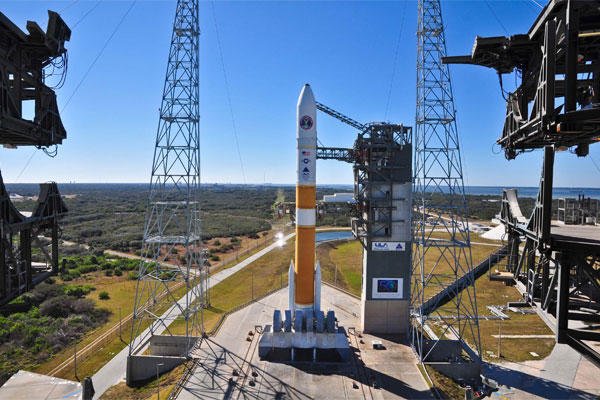The Air Force's first female chief scientist sees a future where satellites are at risk of falling under attack, cyber attacks are common place, and precision lasers mounted to aircraft are a primary weapon.
Many of these concerns were mapped out in a recently published Air Force Science and Technology report called "Global Horizons, United States Air Force Global Science and Technology Vision," Air Force Chief Scientist Mica Endsley told Military.com in an interview.
The report specifies a range of threat areas where the service is placing its dollars and research emphasis to include remotely piloted aircraft, space, cyberspace, electronic warfare, directed energy and the elimination of weapons of mass destruction, among others, she said.
The Global Horizons paper also cites space as an area of growing concern for Air Force scientists and researchers. For example, satellites which provide GPS signals to military forces may wind up being targeted by enemies or potential enemies as space becomes more congested and contested, Endsley added.
"We need to be resilient to those kinds of attacks. We don't have space to ourselves anymore," she explained.
As a result, the Air Force is looking at building cheaper, smaller satellites so as to build in redundancy and spread out systems, allowing capability to sustain itself in the event of an attack, Endsley said.
At the same time, the Air Force hopes to become less reliant on GPS, in part by developing reliable kinds of inertial navigation systems. One such technique, called Cold-Atom-Based-Navigation, is showing promise in laboratory experiments, Endsley explained.
"We want to have technologies that allow us to operate even if GPS signals get interrupted. Cold Atom Navigation is a promising technology as it is a whole new way to get effective timing. It is working in a lab. It gets down to the behavior of atoms when they are super cold and it gives you a precision timing capability that is essential to navigation," Endsley said.
Overall, the Air Force's Research, Development, Test and Evaluation (RDT&E) budget request for fiscal year 2014 is $17.6 billion, a slight increase over the $17.4 billion requested for fiscal year 2013. The post-sequester RDT&E enacted budget for this year, as of June 2013, is $16.2 billion, according to Air Force officials.
The budget for Science and Technology (S&T) accounts are a slice of the RDT&E budget. The service has spent roughly $2 billion per year for the last several years, service officials said.
It's of little surprise that the latest S&T Vision paper would emphasize cyber. It's one of the few sectors of the military that is growing at a time when sequestration has forced generals to cut most programs.
Endsley, who taught at Texas Tech and the Massachusetts Institute of Technology, said the Air Force must do a better job at protecting itself from cyber hackers. She said officials must commit to developing computer networks which are less "penetrable" to cyber attacks.
"All of our technologies, our aircraft, our satellites -- everything -- is sitting on a bed of software and computer hardware. The ability to have reliable, safe, secure computer operations is paramount to what we are doing," she said. "This is not just a future possibility as there are ongoing cyber attacks every day."
Along these lines, Endsley made reference to the recent cyber attack against the New York Times.
Without going into much detail, Endsley explained that there are ways to engineer more resilient computer networks that re-organize themselves in the event of an attack so as not to reveal the structure of the network.
Endsley also emphasized the global proliferation of remotely piloted aircraft (RPAs), saying that the threat environment regarding these technologies -- to include weaponized UAS and smaller swarms of mini-UAS -- is growing exponentially.
"There are literally hundreds of countries that have RPA and we are seeing a real proliferation of them because it is an easier technology to develop and get into. I think we are going to be seeing a much more congested air space regarding RPA in the future," she said.
Meanwhile, the Air Force is working on improving the sensors, feeds and display screens used for UAS technology. In fact, the Air Force Research Laboratory in Dayton, Ohio, is working on looking at how to display information pilots are looking at, Endsley added.
"The research is expanding so that pilots can work with each other and other aircraft. We're working toward an integrated system where manned and unmanned systems are working together to achieve common goals," she explained.
Endsley also said that the Air Force is working to provide RPAs with greater autonomy.
"If you add more autonomy to the system you need to be sure you are integrating the pilot with the autonomy so that the pilot understands what the system is doing and where it is going next," she said.
There is also research going on to improve or streamline the processing of information, data and images collected by UAS sensors. AFRL engineers in Rome, N.Y., are working on algorithms to address these challenges, Endsley said. For instance, a certain algorithm could help the UAS sensor recognize certain relevant objects or signals so that only very relevant information is sent forward to the operator, Endsley explained.
She also said that the Air Force is looking at lasers or directed energy weapons much like the Navy, as the service tries to achieve precision effects at significant distances, rapidly recharge and reduce collateral damage.
"I think it has real advantages. I think it has a lot of potential but there are a few details that need to be worked out to make it durable on aircraft systems," she said.





























